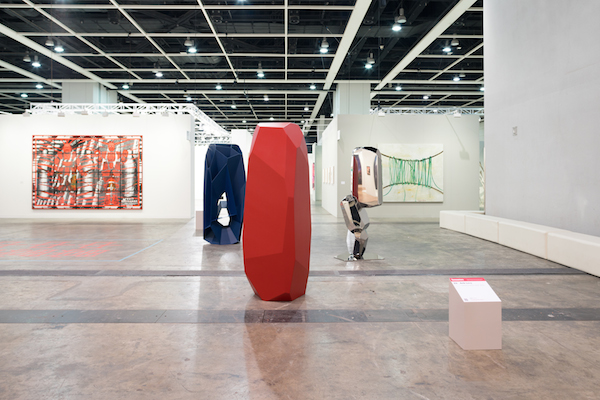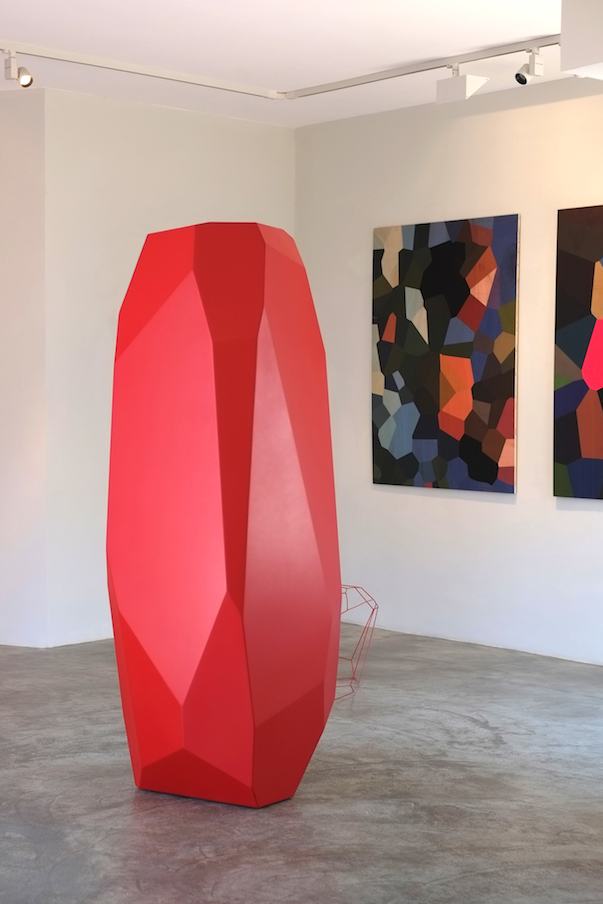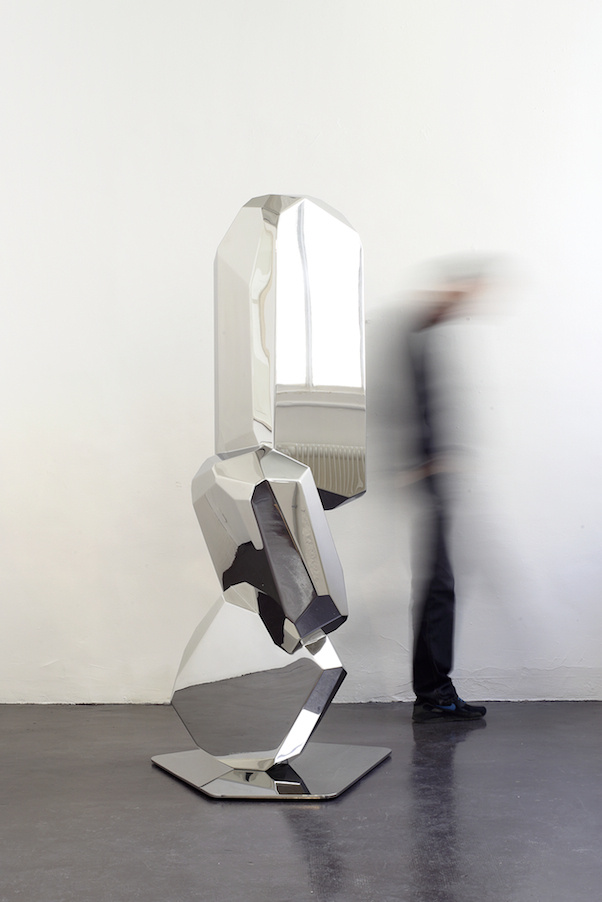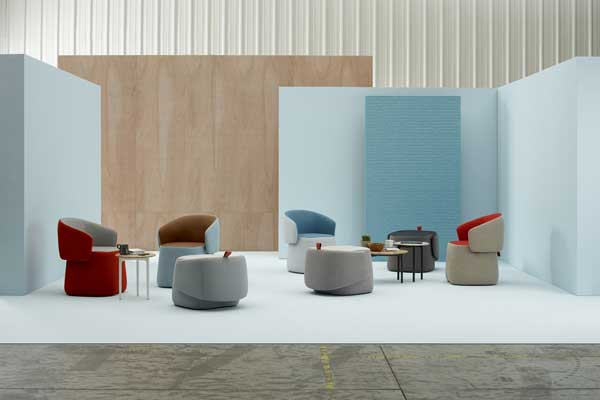The industrial designer talks to Tamsin Bradshaw about genetics, human emotion and social codes.

April 6th, 2016
Arik Levy’s rock sculptures generate thoughts about geology, genetics, biology and sociology all at once. This was certainly the case with his latest installation, a triplet of rock sculptures – Crater F210 Blue, Rock Stone 198 Red and Rock Triple Fusion – which Pékin Fine Arts presented at the 2016 edition of Art Basel in Hong Kong. Together, the three sculptures formed an installation, Intimate Evolution.
The Tel Aviv-born, Paris-dwelling industrial designer’s work is often multidisciplinary – he’s known for his furniture, his film work, his photography and his art, but he’s perhaps most widely known for his rock formation sculptures. Here, he tells us about his latest sculptures, homogeneity and BHP Billiton.

Intimate Evolution on display at Art Basel in Hong Kong last month
Tell us about Intimate Evolution.
It’s a triplet but they live independently. Their connection is more about genetics. Rock Stone 198 Red is stone, it’s the more known typology of my work. It’s starting to be bigger. It’s a little over man size, so it looks at us instead of us looking at it. It has its power, its volume. It relates to totems, to the minerals, but in an extraordinary size. It’s a non-perfected geometry, which gives it its own perfection and its identity. Like humans: we’re all different, but when we go to the toilet, we all go to the same two pictograms.
Then there’s the Crater, this is actually the bone of it, if the Rock Stone would have been distilled. When you distill, you take something away, you get to something which is more concentrated somehow. Here, what happens, it’s distilling, but instead of having 32 facets, you have 90 facets. It’s multiplying and getting better somehow.
It’s like we have one skin, the skin is one piece; if you ripped it, it would more or less come off in one piece, but underneath you have 206 bones.
The third one – the Rock Triple Fusion – is about movement of things that get together and then separate. Getting away from each other, or collapsing, and fusing into each other. It’s like society: people merge and meet, and then they separate. With metal, the moment it fuses, the colours are blue and red.
What’s the significance of the colours you used for these pieces?
Humans decided that blue is cold and red is hot. But a really hot temperature flame is actually blue and not red.
BHP Billiton, you know how it was born? This guy Billiton was flying, and at the time there was no navigation. At that point they would use landmarks to navigate. He was thinking, “So I follow the river and at the red mountain you go left – wait, the mountain is red?” He was very smart and he knew red meant rust, rust meant metal, metal meant money. He got the license to dig forever. His grandson is still getting something like AU$40,000 a week in royalties from that one contract.
I hate what they do, but I respect the fact that he was on it. It’s connected things in such a way that we think of red and we think of power.

Rock Stone 198 Red in all its flame-hued magnificence
What relevance does biomimicry have to your work?
Biomimicry in architecture, for example, is referred into learning from existing structures, like the butterfly wing or the leaf. In my case, biomimicry is about analysing a situation and injecting at that moment one gene: my gene. If you introduce a new gene into a double helix genetic structure, then you get something new. It makes you ask, does it stand or does it not? Is it in balance or is it not balance?
If you look at Rock Triple Fusion, you can really see a human figure. It was not done intentionally, but it was the first time that my work had a figurative nuance to it. It was exciting for me, because I always wanted that. The figurative side of it is silent. When you discover it, you can start seeing it. It’s actually made by the reflection of what’s around it.

Rock Triple Fusion resembles a human figure
How did you find Art Basel in Hong Kong this year?
This specific year, you saw less of the expected works. You saw more diversity and new artists.
It’s a risk in the art industry that you keep on seeing the same thing. You see the same work in a gallery and then in the museum next door, then you fly to New Zealand and you see work by the same artist. You say what is this, are there only five artists in the world? Design is the same, by the way. Architecture is better, because it’s a lot more diverse.
Arik Levy
ariklevy.fr
Pékin Fine Arts
pekinfinearts.com
A searchable and comprehensive guide for specifying leading products and their suppliers
Keep up to date with the latest and greatest from our industry BFF's!

Create a configuration to suit your needs with this curved collection.

Savage Design’s approach to understanding the relationship between design concepts and user experience, particularly with metalwork, transcends traditional boundaries, blending timeless craftsmanship with digital innovation to create enduring elegance in objects, furnishings, and door furniture.

Channelling the enchanting ambience of the Caffè Greco in Rome, Budapest’s historic Gerbeaud, and Grossi Florentino in Melbourne, Ross Didier’s new collection evokes the designer’s affinity for café experience, while delivering refined seating for contemporary hospitality interiors.

Sub-Zero and Wolf’s prestigious Kitchen Design Contest (KDC) has celebrated the very best in kitchen innovation and aesthetics for three decades now. Recognising premier kitchen design professionals from around the globe, the KDC facilitates innovation, style and functionality that pushes boundaries.
The Jones Bay Wharf building is awarded for its sustainable initiatives.

Aside from fresh product, the stand-out at Orgatec was the innovations in activity-based working. Words by David Granger.
The internet never sleeps! Here's the stuff you might have missed

Wood Marsh’s 40-year legacy shines through landmark infrastructure projects. Recently completing stunning stations at Coburg and Moreland, their designs blend modernity with community needs.

Swiss home appliance designer and manufacturer V-ZUG’s first Sydney studio is a unified expression of the brand’s boutique, sustainable and design-led identity.